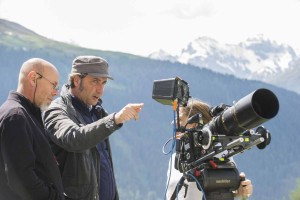
Youth — the title is somewhat ironic — takes place at an elegant old hotel in the Swiss Alps where people have come to relax and rejuvenate at the spa, and for several of the main characters, to ponder their futures after having had long and successful creative careers. The question is not so much about growing old, but having grown old, wondering about what lies ahead. The theme, though serious, with many lengthy conversations filmed in long takes, is also often light-hearted with a playfulness and a visual flair similar to that of another Italian director, the great Federico Fellini, whom Sorrentino acknowledges has been a big influence on him.
Caine plays Fred Ballinger, a renowned but now retired English composer whose foil is his lifelong friend Mick Boyle, played by Keitel, a still somewhat active Hollywood director. Both are about 80 years old. In the beginning of the film, a representative of Queen Elizabeth II asks Fred to conduct his most famous work at a concert before her Royal Highness, but he adamantly declines the request.
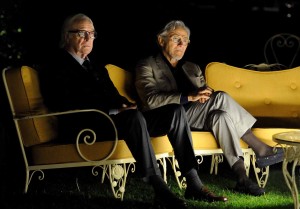
The film’s stylish visuals were the product of Sorrentino’s collaboration with his longtime cinematographer Luca Bigazzi. “It is always difficult for me to talk about Luca because we have known each other for so many years,” said Sorrentino. “When we are together. We talk about all kinds of things except the film and that seems to work. All I told him was that this is the type of film that is totally centered on the characters, so the camera must not call attention to itself.” Nonetheless, the hands-on director comes to each day’s shoot with all the camera work thought out thoroughly.
“I made this film with a digital camera for the first time,” said Sorrentino, despite his preference for the film medium. “There were many long dialogue sequences which are easier to do with a digital camera because it gives you the ability to do much longer takes than with a film camera,” the director explained. Bigazzi used the Red Epic, Zeiss lenses and the first ultra-zoom Canon.
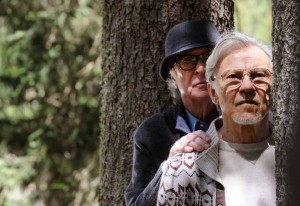 It was the first feature that production designer Ludovica Ferrario worked on with Sorrentino. Her job was focused on creating the right atmosphere, a lush setting where time seems almost suspended, while paying attention to details in the luxurious bedrooms and other spaces. However, her task was somewhat limited on Youth because there were no sets to design. Nearly all of the film was shot at real locations with limited alteration. That’s the preference of the director, who puts a lot of stock in finding precisely the right settings.
It was the first feature that production designer Ludovica Ferrario worked on with Sorrentino. Her job was focused on creating the right atmosphere, a lush setting where time seems almost suspended, while paying attention to details in the luxurious bedrooms and other spaces. However, her task was somewhat limited on Youth because there were no sets to design. Nearly all of the film was shot at real locations with limited alteration. That’s the preference of the director, who puts a lot of stock in finding precisely the right settings.
“I originally looked at a number of possibilities in Italy, but then came upon this antique hotel kept in its original condition that also has a modern spa, which was what I was looking for,” said Sorrentino. So the Berghotel Schatzalp in the Swiss Alps near Davos became the main location. It also had a special allure. The Art Nouveau showplace built in 1900 was originally a luxury sanatorium for tuberculosis patients, and inspired the setting for German Nobel Prize-winning author Thomas Mann’s pre-World War One classic novel, The Magic Mountain.
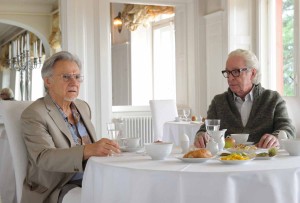 “Since the hotel has ties to Mann, the owners had preserved it meticulously. It is aesthetically very beautiful and consistent with the mood we wanted to establish,” said Sorrentino. It had been converted to a hotel in 1950.
“Since the hotel has ties to Mann, the owners had preserved it meticulously. It is aesthetically very beautiful and consistent with the mood we wanted to establish,” said Sorrentino. It had been converted to a hotel in 1950.
The connection to Mann’s novel also gave it a metaphorical appeal, because in the book the tubercular sanatorium is a waystation between life and death. The director wanted to punctiliously maintain the actual look. “In the dining room, we changed almost nothing, except to hang different pictures,” he said.
Costume designer Carlo Poggioli worked to create clues to the personalities of the characters in their clothing. Caine as the retired conductor had an elegant but well-worn wardrobe made up of old bespoke suits from famous Neapolitan tailor Cesare Attolini and custom knitwear from high-end Lombardy designer Fioroni, which were then aged.
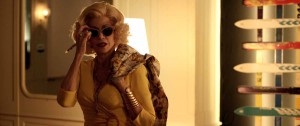 Fonda, who plays an aging but still flamboyant and fiery Hollywood diva actress — she all but steals the movie during a six-minute temper tantrum in front of Boyle — was a special project for both the costume designer and makeup artists Matteo and Maurizio Silvi. Fonda, who, in person, still looks svelte and young although she turns 78 in a few weeks, had a major makeover to look like an 80-year-old beauty queen, but still trying to hang onto her looks. She wears a very artificial blonde wig that complements her bright yellow dress and chains of gold jewelry, with smeary eye make-up on her face and advancing wrinkles. “We really didn’t do that much to change her,” Sorrentino protested, “except giving her that wig and the heavy make-up — and we gave her a mole.”
Fonda, who plays an aging but still flamboyant and fiery Hollywood diva actress — she all but steals the movie during a six-minute temper tantrum in front of Boyle — was a special project for both the costume designer and makeup artists Matteo and Maurizio Silvi. Fonda, who, in person, still looks svelte and young although she turns 78 in a few weeks, had a major makeover to look like an 80-year-old beauty queen, but still trying to hang onto her looks. She wears a very artificial blonde wig that complements her bright yellow dress and chains of gold jewelry, with smeary eye make-up on her face and advancing wrinkles. “We really didn’t do that much to change her,” Sorrentino protested, “except giving her that wig and the heavy make-up — and we gave her a mole.”
Sorrentino especially likes the editing process on a film and on Youth he worked with another longtime collaborator, editor Cristiano Travaglioli. “It’s one of my happiest moments when I start in the cutting room,” he said. He usually avoids dailies, preferring to see the footage fresh in the first assembly. “Sometimes when watching it I don’t remember that I shot it because it was months ago,” he declared.
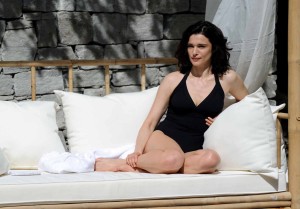 Music is both an important theme and component of Youth. Ballinger finally relents and agrees to conduct his most famous work, “Simple Song #3” at a concert with the Queen in attendance, ending the movie at an emotional high point with the rapturous melody sung by world-famous opera star Sumi Jo. The song and its lyric were written by classical composer David Lang who also scored the film. “David wrote the score and the song before I started filming so I could use it during the shoot,” said the director. It was Sorrentino, and not the composer, who selected the Korean-born soprano. She is listed as an actor in the film under her own name and appears at the finale singing in a brilliant red dress against a white backdrop. The scene was filmed in the Wimbledon Concert Hall, near the famous tennis stadium.
Music is both an important theme and component of Youth. Ballinger finally relents and agrees to conduct his most famous work, “Simple Song #3” at a concert with the Queen in attendance, ending the movie at an emotional high point with the rapturous melody sung by world-famous opera star Sumi Jo. The song and its lyric were written by classical composer David Lang who also scored the film. “David wrote the score and the song before I started filming so I could use it during the shoot,” said the director. It was Sorrentino, and not the composer, who selected the Korean-born soprano. She is listed as an actor in the film under her own name and appears at the finale singing in a brilliant red dress against a white backdrop. The scene was filmed in the Wimbledon Concert Hall, near the famous tennis stadium.
Youth is Sorrentino’s second English-language movie, determined by his casting of English-speaking actors, in this case starting with Caine. “I wrote the screenplay in Italian and I have a wonderful translator,” he said. His previous English-language film was This Must Be the Place in 2011 starring Sean Penn and Frances McDormand. His next project is also in English and this time it’s for television, an ambitious five-part 10-hour series for HBO about the Vatican, The Young Pope, staring Jude Law and Diane Keaton. His usual cinematographer, DP Bigazzi did the lensing. “It was like making five movies,” said the director. Already completed, it starts airing on the premium service early next year.





